THE MINES
See also the menus for cables and all mines.
There has been mining activity in Granada and Almería since neolithic times, mainly for copper, iron and lead. There is evidence of mining in Los Millares between the years 3300 and 2600BC, during the Chalcolithic Period. During the epoch of El Argar there were many mines created, the Argaric culture having spread to the whole of the Spanish peninsula around the years 2300 - 1800BC. Many peoples have passed through the area over the millenia and most have excavated the iron ore and lead from the ground. Mining in the Sierra de Los Filabres started in earnest around 1903 with a number of companies extracting iron ore, however the first concessions were registered in 1870 by a Don Ignacio Gómez de Salazar. For many years the iron ore had to be carried manually and by mule down from the mountains over 70km to the coast to load onto ships, sometimes via a beach. Then in 1894 the GSSR arrived in Serón.
The Bacares Iron Ore Mines Ltd.
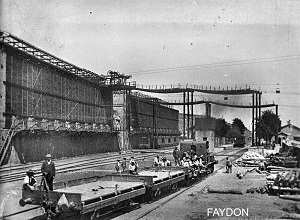 In around 1902/4 the 'Bacares - Serón Ropeway Co. Ltd.' installed a cableway from the Bacares mines ('The English') to Serón Station where a huge hopper had been built. All of this was mainly thanks to a brilliant Englishman called Gustave Gillman who was station master of Águilas Station at the time but who went on to play an enormous part in the fortunes of the GSSR. This cable system, by Ropeways Ltd carried the ore in 480kg buckets at a rate of 120 per hour (approximately 10km/h) which brought a total of 500 tons of ore to Serón per day (approximately 175,000 tons per year). The Serón hopper had a capacity of 3,000 - 4,500 tons, allowing up to a week's worth of ore to be stored. The ore was then loaded onto GSSR trains whose wagons were specially designed to match the chutes from the hopper to avoid excessive shunting. Each wagon held a load of 35 tons and there were 12 wagons to a train - a total load of 420 tons. With the weight of the rolling stock, each mineral train weighed around 600 tons. The cableway had no power, movement being totally by gravity. There were braking systems at the top and bottom of the cableway to prevent the buckets running away with themselves, and tensioners at different points on the cableway.
In around 1902/4 the 'Bacares - Serón Ropeway Co. Ltd.' installed a cableway from the Bacares mines ('The English') to Serón Station where a huge hopper had been built. All of this was mainly thanks to a brilliant Englishman called Gustave Gillman who was station master of Águilas Station at the time but who went on to play an enormous part in the fortunes of the GSSR. This cable system, by Ropeways Ltd carried the ore in 480kg buckets at a rate of 120 per hour (approximately 10km/h) which brought a total of 500 tons of ore to Serón per day (approximately 175,000 tons per year). The Serón hopper had a capacity of 3,000 - 4,500 tons, allowing up to a week's worth of ore to be stored. The ore was then loaded onto GSSR trains whose wagons were specially designed to match the chutes from the hopper to avoid excessive shunting. Each wagon held a load of 35 tons and there were 12 wagons to a train - a total load of 420 tons. With the weight of the rolling stock, each mineral train weighed around 600 tons. The cableway had no power, movement being totally by gravity. There were braking systems at the top and bottom of the cableway to prevent the buckets running away with themselves, and tensioners at different points on the cableway.
Las Menas
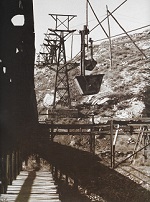
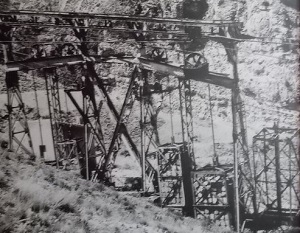 Las Menas was developed and run initially by a Belgian company called 'Compagnie des Mines et Chemins de Fer Bacarès - Alméria', the drilling and testing being done by 'W.H. Müller et Cíe'. 'W.H. Müller' actually took over the mines in 1915. It sold the Las Menas concessions to the Scottish company 'Cabarga San Miguel' and later, in 1925, formed an association with it to create 'Sociedad Minera Cabarga San Miguel'. In the 1950s, this company invested a huge amount of money, effectively building a whole mining village, as well as an 8km cableway and a huge hopper/loader in Los Canos. The cable from Las Menas to Los Canos was manufactured by W.H. Müller y Cía and built by Adolfo Bleichert y Cía of Leipzig. It transported 1,200 tons per day. It comprised 103 columns and 8km length. The loader in Las Menas had a capacity of 8,000 tons and had tunnels beneath the hopper for the purpose of loading the trains which went down to El Horrnillo. This loader also had tensioners as did the intermediate station to keep the cable taut. The loader was loaded via a chute whereby ore from different mines was discharged into the hopper. The ore was then loaded onto wagons via a system of tunnels and conduits. See all images.
Las Menas was developed and run initially by a Belgian company called 'Compagnie des Mines et Chemins de Fer Bacarès - Alméria', the drilling and testing being done by 'W.H. Müller et Cíe'. 'W.H. Müller' actually took over the mines in 1915. It sold the Las Menas concessions to the Scottish company 'Cabarga San Miguel' and later, in 1925, formed an association with it to create 'Sociedad Minera Cabarga San Miguel'. In the 1950s, this company invested a huge amount of money, effectively building a whole mining village, as well as an 8km cableway and a huge hopper/loader in Los Canos. The cable from Las Menas to Los Canos was manufactured by W.H. Müller y Cía and built by Adolfo Bleichert y Cía of Leipzig. It transported 1,200 tons per day. It comprised 103 columns and 8km length. The loader in Las Menas had a capacity of 8,000 tons and had tunnels beneath the hopper for the purpose of loading the trains which went down to El Horrnillo. This loader also had tensioners as did the intermediate station to keep the cable taut. The loader was loaded via a chute whereby ore from different mines was discharged into the hopper. The ore was then loaded onto wagons via a system of tunnels and conduits. See all images.
Click on the map to see each building
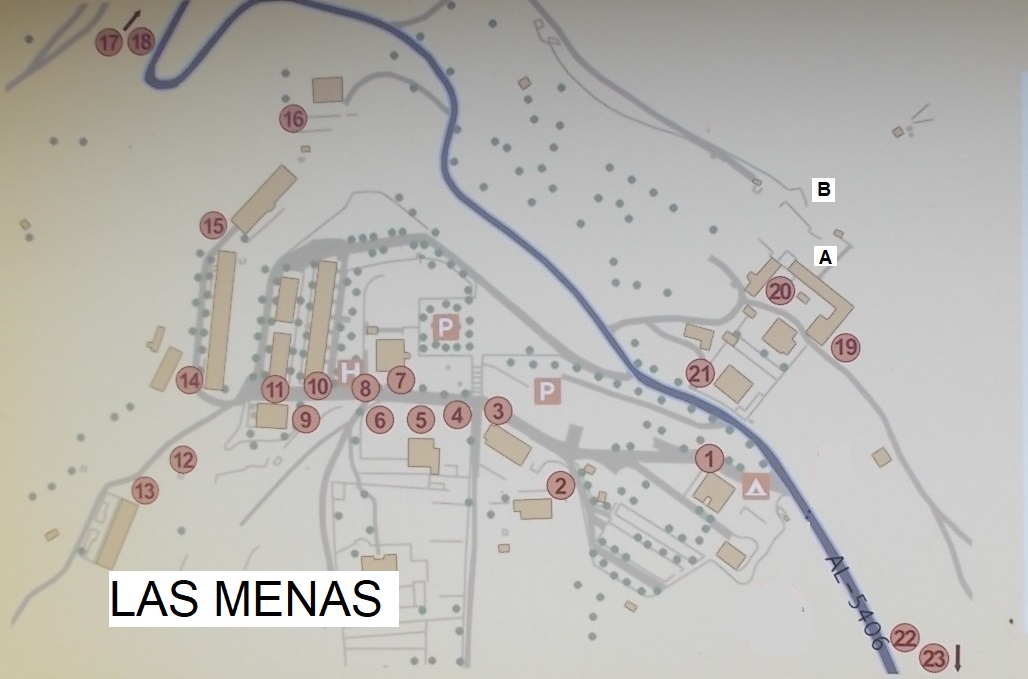
Cableways
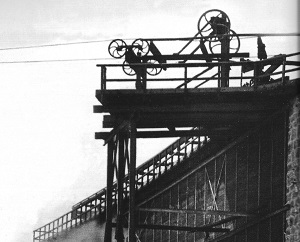
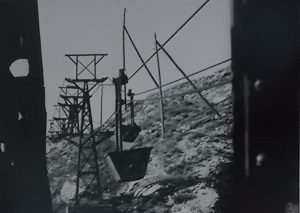 Eventually, there were a number of cableways from different mines: the Tesorero mine to Km 108 between Hijate and Serón, Gran Coloso / Cuevas Negras to Km 95 between Serón and Tíjola, and Las Menas/San Miguel to Los Canos, all of which were carrying ore to be loaded onto the GSSR. These cableways were impressive constructions considering the topography of the area and the distances involved:
Eventually, there were a number of cableways from different mines: the Tesorero mine to Km 108 between Hijate and Serón, Gran Coloso / Cuevas Negras to Km 95 between Serón and Tíjola, and Las Menas/San Miguel to Los Canos, all of which were carrying ore to be loaded onto the GSSR. These cableways were impressive constructions considering the topography of the area and the distances involved:
| Cable name | Length (km) | Destination | Number of sections | Comments |
|---|---|---|---|---|
| Manzano | 10.477 | Serón | 3 | This cable was the first of the cableways to be constructed (by The Bacares Iron Ore Mines Co.). It served three mine areas - Las Menas, Manzano and La Leona. There was a junction 5.7km from Serón Station where the three cables joined. |
| Cortijuelo | 13.684 | Serón | 5 | Due to the need for increased transport of ore, this cable was built by the same company and serviced the mining areas of Las Menas, El Cortijuelo, Francia, Perdigones and San Ignacio. |
| Los Canos | 8.104 | Los Canos | 5 | This cable carried ore to Los Canos from Las Menas, Dulce María and Ramalillo. The system was by 'Bleichert' and was of the two cable design. The loading (down) cable was 40mm in diameter and the empty (up) cable 25mm. The tractor cable was 27mm. The cable could carry 1,200 tons in 10 hours. |
| Bacares | 11.5 | Las Menas | ??? | This cable carried ore from The Bacares Mines to the Las Menas loader for it to be carried down to Los Canos. |
| Tesorero | 15 | Km 108 | 2 | From the Tesorero mines to the loader between Hijate and Serón stations. |
| Cuevas Negras/Gran Coloso | Tíjola | 6,730 | 2 | Cuevas Negras mines opened around 1902 and carried ore to the GSSR loader at Tíjola. The cableway opened around 1902-3 and ran until 1910 when the mine closed. The cableway was then sold in the same year to Gran Coloso mine which then ran until 1916. |
Los Canos
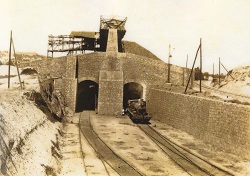 Los Canos is situated at km 98 on the GSSR. The hopper held 40,000 tons of ore which was discharged directly onto the 10 wagons of 40 tons each which were underneath in the tunnels, and this only took 5 minutes. The cable was fixed to a wall which was 16m high and which allowed the ore to be discharged into each of the hoppers. This meant that there was always ore ready for when a train was available. This superbly designed loader worked well for many years.
Los Canos is situated at km 98 on the GSSR. The hopper held 40,000 tons of ore which was discharged directly onto the 10 wagons of 40 tons each which were underneath in the tunnels, and this only took 5 minutes. The cable was fixed to a wall which was 16m high and which allowed the ore to be discharged into each of the hoppers. This meant that there was always ore ready for when a train was available. This superbly designed loader worked well for many years.
The Workshops
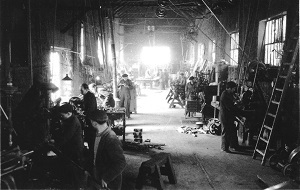 The workshops were always frenetic, repairing machinery and tools. There was a workshop manager whose house was nearby, an assistant manager and five security officers. The working day was from 08:00hrs to 17:00hrs with an hour's lunch break. Memories of José Francisco Torreblanca and his son:- 'The varied areas were intended for works such as forging, carpentry and diesel repairs. The workshop was next to the 200HP 150kVA 250V generator. In these workshops there was also a group of workers who delivered firewood to the living quarters, and were responsible for managing all of the material that came up on the cable (new tools, machinery etc,) and to deal with any emergencies that might occur in the mining community.
The workshops were always frenetic, repairing machinery and tools. There was a workshop manager whose house was nearby, an assistant manager and five security officers. The working day was from 08:00hrs to 17:00hrs with an hour's lunch break. Memories of José Francisco Torreblanca and his son:- 'The varied areas were intended for works such as forging, carpentry and diesel repairs. The workshop was next to the 200HP 150kVA 250V generator. In these workshops there was also a group of workers who delivered firewood to the living quarters, and were responsible for managing all of the material that came up on the cable (new tools, machinery etc,) and to deal with any emergencies that might occur in the mining community.
The General Store
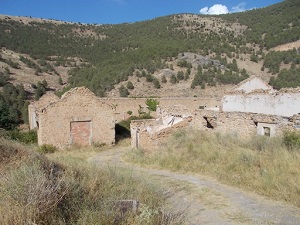 The general store was responsible for the receipt, storage and supply of all materiel for the company. The General Store was important in the life of Las Menas because the ordinary workers could get items such as lightbulbs, taps, glass etc., with a chit from the director. In 1911 an expert driller, Don José Castillo, who taught the other miners the art of drilling, arrived. He became the Store Manager in 1913, where he remained for 45 years until his death.
The general store was responsible for the receipt, storage and supply of all materiel for the company. The General Store was important in the life of Las Menas because the ordinary workers could get items such as lightbulbs, taps, glass etc., with a chit from the director. In 1911 an expert driller, Don José Castillo, who taught the other miners the art of drilling, arrived. He became the Store Manager in 1913, where he remained for 45 years until his death.
The mines
Mina Necesaria in Las Menas gorge was exploited by 'Compagnie des Mines et Chemins de Fer Bacarès - Alméria' until 1925, whereby it passed to 'La Sociedad Minera Cabarga San Miguel'.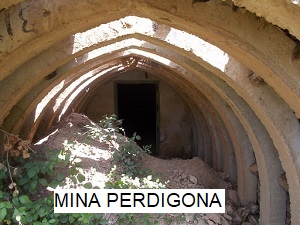 In these times, the ore was extracted by pick and shovel, using mules for its transport. In the latter years, the mine was modernized and had pumped air in all of the galleries for the pneumatic drills as well as diesel transport of ore. The entrance of Perdigona mine is supported by concrete shafts (like rib cages) which were used in the latter years of exploitation. This mine was in production, along with Jota and Concepción up until the closure of the company. Shifts were 07:00-15:00, 15:00-23:00 and 23:00-07:00, without break. Work in the mine never stopped. There were two teams for each shift, miners and outsiders. All carried 'carburos' - lamps that worked by calcium carbide. The mine was directly under the Director of Exploitation, under whom were the directors of works, drilling, health, mule management, mine construction, shafts, general workers and gofers.
In these times, the ore was extracted by pick and shovel, using mules for its transport. In the latter years, the mine was modernized and had pumped air in all of the galleries for the pneumatic drills as well as diesel transport of ore. The entrance of Perdigona mine is supported by concrete shafts (like rib cages) which were used in the latter years of exploitation. This mine was in production, along with Jota and Concepción up until the closure of the company. Shifts were 07:00-15:00, 15:00-23:00 and 23:00-07:00, without break. Work in the mine never stopped. There were two teams for each shift, miners and outsiders. All carried 'carburos' - lamps that worked by calcium carbide. The mine was directly under the Director of Exploitation, under whom were the directors of works, drilling, health, mule management, mine construction, shafts, general workers and gofers.
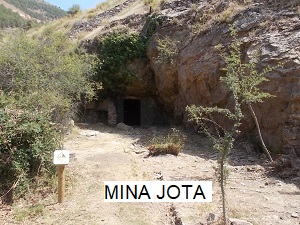 Below the General Store there are two easily accessible mines - Jota and La Perdigona, which you can get to via a wooden bridge. The ore from these mines was transported via a narrow gauge railway to the loader which then sent the ore to Los Canos via an arial cable. Originally, the trains were pulled by mules, but much later, in the 1950s, the traction was by Deutz diesel locos. Jota was one of the last mines to close, that being in 1968. In the latter years, it had electric light, but the miners still carried their carbide lamps. The mines were horizontal, and when exhausted were filled with hardcore to prevent cave-ins. The company had three quarries for this purpose. More recently, La Perdigona was used by one Don Renato to grow mushrooms.
Below the General Store there are two easily accessible mines - Jota and La Perdigona, which you can get to via a wooden bridge. The ore from these mines was transported via a narrow gauge railway to the loader which then sent the ore to Los Canos via an arial cable. Originally, the trains were pulled by mules, but much later, in the 1950s, the traction was by Deutz diesel locos. Jota was one of the last mines to close, that being in 1968. In the latter years, it had electric light, but the miners still carried their carbide lamps. The mines were horizontal, and when exhausted were filled with hardcore to prevent cave-ins. The company had three quarries for this purpose. More recently, La Perdigona was used by one Don Renato to grow mushrooms.
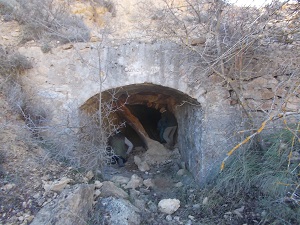 Mina Concepción was slightly to the north of Las Menas in an area called 'Los Cortijillos'. It was 1.45km long and the ore was taken by narrow gauge railway to the entrance of the mine, and hence by cable to the main loader in Las Menas. La Concepción is only one of many mines in the area of Las Menas, El Rascator, Bacares, La Perdigona, Las Perdigones etc. which were exploited over a period of over eighty years between the 1890s and the 1980s.
Mina Concepción was slightly to the north of Las Menas in an area called 'Los Cortijillos'. It was 1.45km long and the ore was taken by narrow gauge railway to the entrance of the mine, and hence by cable to the main loader in Las Menas. La Concepción is only one of many mines in the area of Las Menas, El Rascator, Bacares, La Perdigona, Las Perdigones etc. which were exploited over a period of over eighty years between the 1890s and the 1980s.
The General Office
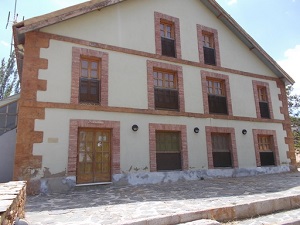 The General Office was the heart of Las Menas. On the ground floor was the administration: the cashier, the office manager, accounts department, salaries and the telephone exchange as well as the Director General's office which had a waiting room with three lights: white: no-one in; red: busy; and green: enter. The first floor was the technical offices, drawing offices and surveying, the office of the head of mine engineering and guest areas for the company directors and visitors. Up until 1925, the second floor was used as accommodation for visitors to Las Menas, after which Federico Bererroonde installed a casino with a bar in which only liquores and cafe were served, with a pool (snooker?) table around which were divans and tables arranged for meetings - a room for recreation as well as being a small library....with a piano. This area was only accessible to the priviledged of Las Menas, to bring their wives to meet up, read and enjoy music. This building was converted to an hotel but is now abandoned.
The General Office was the heart of Las Menas. On the ground floor was the administration: the cashier, the office manager, accounts department, salaries and the telephone exchange as well as the Director General's office which had a waiting room with three lights: white: no-one in; red: busy; and green: enter. The first floor was the technical offices, drawing offices and surveying, the office of the head of mine engineering and guest areas for the company directors and visitors. Up until 1925, the second floor was used as accommodation for visitors to Las Menas, after which Federico Bererroonde installed a casino with a bar in which only liquores and cafe were served, with a pool (snooker?) table around which were divans and tables arranged for meetings - a room for recreation as well as being a small library....with a piano. This area was only accessible to the priviledged of Las Menas, to bring their wives to meet up, read and enjoy music. This building was converted to an hotel but is now abandoned.
The Cinema
The cinema opened in the 1940s. When it opened, films were shown free, but later there was a charge to cover the cost of the rental of the film, originally one peseta up to 3 pesetas in 1966. Nearly all of the residents of Las Menas were frequent visitors to the cinema, normally using the same seats (we are all people of habit). The cinema showed films on Saturdays and Sunday afternoons. The building was also used as a theatre where plays were acted.
The School
The school was built in 1918 and the teachers were given accomodation and firewood as well as a salary.
Barracks
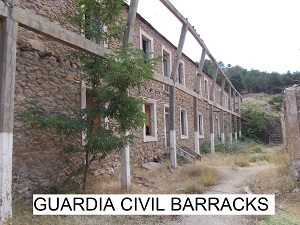 The Guardia Civil barracks were built in about 1930 as a result of the company requesting their presence, and for which they paid part of the costs of construction. There was accomodation for eight families with the apartments on the first floor accessible directly by exterior staircases. The apartments had three bedrooms, a dining/sitting room, a bathroom and a kitchen. On the right there was a hut which secured the front gate, and which had a fireplace for Winter. On the left there was a hut which was the armoury. The barracks, in the latter years, had a commandant and seven civil guards. These guards had the same rights as the directors of Las Menas, namely access to the casino and free firewood, electricity, water and coal.
The Guardia Civil barracks were built in about 1930 as a result of the company requesting their presence, and for which they paid part of the costs of construction. There was accomodation for eight families with the apartments on the first floor accessible directly by exterior staircases. The apartments had three bedrooms, a dining/sitting room, a bathroom and a kitchen. On the right there was a hut which secured the front gate, and which had a fireplace for Winter. On the left there was a hut which was the armoury. The barracks, in the latter years, had a commandant and seven civil guards. These guards had the same rights as the directors of Las Menas, namely access to the casino and free firewood, electricity, water and coal.
Miner's Monument
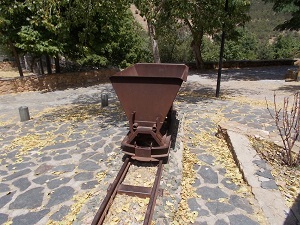
 In front of the doctor's house is the Miners' Monument. On 13th August 2000, this monument to the miners of Las Menas was inaugurated. It symbolizes the transfer of a wagon of ore from the bowels of Mina Concepción. Later, there were added the mines Necesaria and Jota. The monument has a list of the miners who passed through, and left their mark in, Las Menas.
In front of the doctor's house is the Miners' Monument. On 13th August 2000, this monument to the miners of Las Menas was inaugurated. It symbolizes the transfer of a wagon of ore from the bowels of Mina Concepción. Later, there were added the mines Necesaria and Jota. The monument has a list of the miners who passed through, and left their mark in, Las Menas.
The Inclined Plane
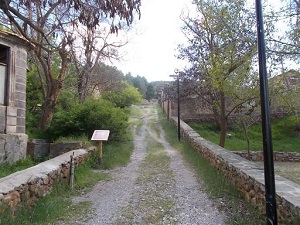 The inclined plane was used to bring ore from the Esparteña mine. The narrow gauge railway brought the ore down from the mine where it was loaded into carts which were pulled by mules which took the ore to the loader.
The inclined plane was used to bring ore from the Esparteña mine. The narrow gauge railway brought the ore down from the mine where it was loaded into carts which were pulled by mules which took the ore to the loader.
The Doctor
 The doctor's house was the residence and office of the doctor who was responsible for the wellbeing of all of the employees of the company, who paid his wages. He was responsible for the patients in the hospital, and was required to do rounds in the hospital every morning as well as dealing with any emergencies. All employees had to have a 6 monthly check-up, and there were emergency practices as well as further training for the ancillary staff. The doctor received all of the priviledges of the company including telephone, stabling, transport, heating, gardeners and houseboys.
The doctor's house was the residence and office of the doctor who was responsible for the wellbeing of all of the employees of the company, who paid his wages. He was responsible for the patients in the hospital, and was required to do rounds in the hospital every morning as well as dealing with any emergencies. All employees had to have a 6 monthly check-up, and there were emergency practices as well as further training for the ancillary staff. The doctor received all of the priviledges of the company including telephone, stabling, transport, heating, gardeners and houseboys.
Accommodation
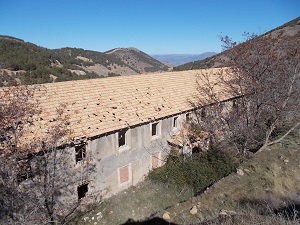 In the 1950s there was built accomodation for the miners and their families. This comprised two buildings for miners with family, a company store, a bakery, and two single miners' residences. In the day, they must have seemed the ultimate in luxury, having running water, electricity and sewerage. In addition, there was a weekly ration of free firewood and a daily ration of bread. Some of these were recently converted to apartments linked to the hotel, which is now abandoned, as is the whole site. Much of the accommodation has been vandalized and is covered with graffiti as well as having suffered from the ravages of the Las Menas Winters.
In the 1950s there was built accomodation for the miners and their families. This comprised two buildings for miners with family, a company store, a bakery, and two single miners' residences. In the day, they must have seemed the ultimate in luxury, having running water, electricity and sewerage. In addition, there was a weekly ration of free firewood and a daily ration of bread. Some of these were recently converted to apartments linked to the hotel, which is now abandoned, as is the whole site. Much of the accommodation has been vandalized and is covered with graffiti as well as having suffered from the ravages of the Las Menas Winters.
Mine manager's house
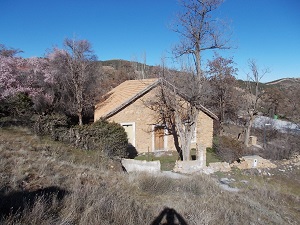 This was the house of the manager who was responsible for all day-to-day activities in the mines. The original roof no longer exists and has been replaced by a temporary sheet metal roof to protect the rest of the building from the elements.
This was the house of the manager who was responsible for all day-to-day activities in the mines. The original roof no longer exists and has been replaced by a temporary sheet metal roof to protect the rest of the building from the elements.
Hospital
 This was equipped with the facilities needed to treat emergencies as well as general illnesses amongst the 3,000 miners and their families. Appointed with an operating theatre, radiology, clinic etc.
This was equipped with the facilities needed to treat emergencies as well as general illnesses amongst the 3,000 miners and their families. Appointed with an operating theatre, radiology, clinic etc.
The doctor was also responsible for routine check-ups of all staff, checking for infectious diseases as well as occupational illnesses from working underground.
The building is now a restaurant attached to the Las Menas camping site.
Statistics of iron ore transported by the GSSR (tons)
| Year | Tíjola | Los Canos | Serón | Kilo 108 (Tesorero) | Other mines* | TOTAL |
|---|---|---|---|---|---|---|
| 1897 | ¤ | ¤ | 10 ¶ | ¤ | 28,349 | 28,359 |
| 1898 | 40 ¶ | ¤ | 1,010 ¶ | ¤ | 59,944 | 60,994 |
| 1899 | 59 ¶ | ¤ | 650 ¶ | ¤ | 105,891 | 106,600 |
| 1900 | ƒ | ¤ | ƒ | ¤ | 122,373 | 122,373 |
| 1901 | ƒ | ¤ | ƒ | ¤ | 105,950 | 105,950 |
| 1902 | ƒ | ¤ | ƒ | ¤ | 100,745 | 100,745 |
| 1903 | 11,080 | ¤ | 16,820 | ¤ | 113,616 | 141,516 |
| 1904 | 67,835 | ¤ | 59,133 | ¤ | 69,321 | 196,289 |
| 1905 | 82,152 | ¤ | 167,200 | ¤ | 92,318 | 341,670 |
| 1906 | 72.313 | ¤ | 218,459 | ¤ | 107,268 | 398,040 |
| 1907 | 64,487 | ¤ | 214,389 | ¤ | 124,396 | 403,272 |
| 1908 | 29,164 | ¤ | 220,153 | ¤ | 70,711 | 320,028 |
| 1909 | 35,396 | ¤ | 252,292 | 21,190 | 53,086 | 361,964 |
| 1910 | 4,845 | ¤ | 312,442 | 46,493 | 78,713 | 442,493 |
| 1911 | 44,491 | ¤ | 279,730 | 29,386 | 103,709 | 457,316 |
| 1912 | 50,109 | 195,106 | 300,483 | 19,092 | 73,491 | 638,281 |
| 1913 | 36,751 | 264,834 | 319,882 | 26,982 | 62,076 | 710,525 |
| 1914 | 17,558 | 209,921 | 229,849 | 21,485 | 56,596 | 515,409 |
| 1915 | 13,886 | 181,856 | 271,234 | 1,637 | 24,577 | 493,190 |
| 1916 | 3,054 | 256,264 | 278,217 | ƒ | 27,107 | 564,642 |
| 1917 | 56 | 272,616 | 178,429 | ƒ | 58,807 | 509,908 |
| 1918 | 20 | 97,922 | 80,918 | 20,692 | ƒ | ƒ |
| 1919 | § | 276,964 | 177,576 | § | 31,278 | 485,818 |
| 1920 | § | 217,028 | 172,381 | 1,931 | 14,037 | 405,377 |
| 1921 | § | 120,336 | 27,001 | § | 2,325 | 149,662 |
| 1922 | § | 242,477 | 52,327 | § | 156 | 294,960 |
| Total | 533,296 | 2,336,124 | 3,840,585 | 178,196 | 1,686,840* | 8,576,793 |
*Note: the column entitled 'Other mines' is an approximation of the metal ores from mines such as in the mountains of Sierra de Enmedio, Aguilón, Almagro, Amian, Baza, Estancias, Filabres and Almenara. ¤ = Loader not yet built, § = mine and loader closed, ¶ = iron ore carried to The GSSR on mules, ƒ = data missing. The total is equivalent to £600 million at today's rates.
The following table shows the relative costs to the mines of the extraction and transport of iron ore:
| ITEM | PESETAS | PROPORTION % |
|---|---|---|
| Cost at mine head, eg explosives, labour, depreciation, interest. | 5.86 | 25.8 |
| Cable transport | 2.34 | 10.3 |
| Rail transport and loading on ship. | 5.86 | 25.8 |
| Commission and various costs. | 0.59 | 2.6 |
| Shipping. | 7.32 | 32.2 |
| Sales costs. | 0.73 | 3.2 |
| Cost at destination. | 22.70 | 100 |
From this table we can see that the cost of transport to the ship (8.79 pesetas) was half as much again as the costs at the mine head (5.86 pesetas), thus costing 14.65 pesetas at loading. The GSSR costs to the mines were exactly the same as the costs of extracting the mineral. All of this resulted in the total cost at Middlesborough Port to be 22.70 pesetas, four times that at the mine head.

